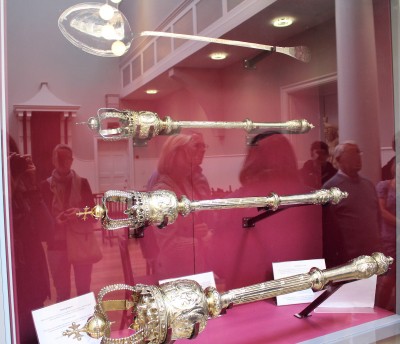Salisbury Guildhall, in the Market Square, is the local council building. Built in the 18th century and home to the Oak Court, a replica of the Old Bailey, the building is often open for visitors to pop in and have a quick look around, to learn more about Salisbury’s municipal history. Sometimes there are free guided tours which include the jail cells and other areas not normally accessible to the public.

Salisbury Guildhall was built in the 18th century, although there has been a building on the site since the early 14th century. The original was built in the early 1300s and was known as The Bishop’s Guildhall, and it was from here that the Bishops would exercise their feudal rights of criminal and civil justice.
In 1585, the Merchant’s Guild built a new headquarters nearby, calling it the Council House. After a mayoral banquet in November 1780, the Council House burnt down. The second Earl of Radnor offered to pay for the construction of a new one, but stipulated that it must be in the centre of the Market Square. His offer was politely refused until he agreed to a different location. After some discussion over which direction the building should face, which the Earl again lost; construction could finally go ahead.

The opportunity was taken to demolish the Bishop’s Guildhall at the same time; it was in a terrible condition as the Bishop didn’t have the money to pay for its upkeep. The Bishop agreed willingly to the plans, and managed to convince the town corporation that they must include a gaol, allow space to hold the Bishop’s Court, the Courts of Dean and Chapter and the sessions for the Close, with the Bishop having no responsibility for the upkeep of the buildings.
Payment to the city Gaoler had to be done by the Corporation but only with the Bishop’s approval. In exchange, the Bishop gave up his role as Clerk of the Market, handing it over the city. In 1795 an Act of Parliament was passed to enable these changes, the Bishop’s Guildhall was demolished and the new Guildhall was built on its site.

Designed by Sir Robert Taylor, it was completed in 1795. Additions and alterations were made over the years, with a grand jury room added in 1829.

The grand entrance to the building has a sweeping staircase, underneath which is a fireplace which is the sole survivor of the 1780 fire in the Merchant’s Guild.
The banqueting hall is the principal room of the Guildhall and has hosted many important guests over the years, including King George III, Lord Nelson, Princess
Diana and the current Queen. The walls are covered with an extensive picture collection, mostly of royalty, benefactors and Salisbury’s Mayors. There are some impressive chandeliers which were once candle powered and which date from 1797.
Ladies of the Queen Mary Needlework Guild making uniforms for the military at a sewing party in the Banqueting Hall during World War I, and the same view of the room today.
The Crown Court dealt with all court matters from 1795 – 2010. Now cleared of all of its court room furniture and tiered seating, the room has been re-designed to allow it to be used for Council functions. The trap door in the floor is now sealed but it was through here that the accused would ascend some very narrow stairs to the dock, to appear before the judge. Many would then have to return back down those stairs to the tiny gaol cells which are below.

In January 1831, 339 cases from the Agricultural Swing Riots, a widespread revolt against harsh conditions and increased mechanisation of agriculture, were heard here, which resulted in 150 people being transported to Tasmania and two death sentences, which were later reprieved.
It was also here that William Wright was sentenced to death, the last execution in nearby Fisherton Gaol in 1855. He had killed his common-law wife when she said she was going to leave him for another man, cutting her neck with a razor. He then turned the razor upon himself, cutting his throat but surviving. Newspaper reports say that when he was hanged, his wound re-opened, making it a particularly grisly sight.
The tour guide in the centre of this picture is standing on the trap door that led to the jail cells. The Three Maces are still used for ceremonial occasions.
The room now contains some of Salisbury’s silver collection, including three George II silver maces. These were commissioned in 1749 and are unique in England. The largest mace is the second biggest in the country. There is also the basting spoon made for the Diamond Jubilee of Queen Victoria in 1897, used for basting an ox which was roasted in the Market Square.
It is also here that you can see the Victoria Cross of Thomas Adlam. This is the highest and most prestigious award for gallantry in the face of the enemy that can be awarded to a soldier. He lived in 2 Farley Road in Salisbury and received the medal for his actions in 1916 in the Somme, when he ‘rushed from shell hole to shell hole under heavy fire … was wounded in the leg but nevertheless, … captured the position and killed the [enemy] occupants.’

The Oak Court is modelled on the Central Criminal Court of England and Wales, otherwise known as The Old Bailey. This court is exactly how you imagine court rooms to be based on every courtroom drama you may have seen on TV. With oak furniture throughout, a grand judge’s chair and an elevated dock for the accused, this is very impressive room.
Used until 2010 as a Magistrate’s Court, it is now host to meetings and marriage ceremonies.
In 1827, Justice Park sentenced 28 people to death in this room; one of them just for the crime of stealing half a crown. All but three were eventually reprieved. He gave one 18 year old lad life transportation for stealing a pocket handkerchief.
In 1830, in the Salisbury Spring Assizes, Justice Gazalee addressed the Grand Jury saying that none of the crimes appeared to be ‘marked with circumstances of great moral turpitude.’ Nevertheless, of 130 prisoners he sentenced 29 to death, life transportation for five, 14 years for five, seven years for 11 and hard labour for the rest.
The jail cells are tiny and only have space for one small and uncomfortable looking seat.
The cells are below the main court rooms. There were originally two tiers of cells, one for men and one for women, but the ones for women have now been converted into council offices.
What remains is the lower level of cells, four tiny rooms which lead off the lower tunnels. Used until 2000, they are no longer in use as they contravene all sorts of rules and regulations for the treatment of prisoners.
They are said to be haunted and people have reported hearing the jangling of keys and footsteps in them.
VISITING SALISBURY GUILDHALL
How to get to Salisbury Guildhall
Postcode: SP1 1JH
What3words: become.washed.purely
Public Transport: There are several bus stops opposite the Guildhall Square, on Blue Boar Row.
Parking: There is no parking on site, but as it is in the centre of town, it is easily accessible from all of the central car parks.
When is Salisbury Guildhall open?
Monday – Friday: 9am - 5pm
Events for the public are often held on Saturdays
How much does it cost to visit Salisbury Guildhall?
Entrance is free unless you are visiting one of the events that are sometimes held.
For free guided tours, keep an eye on the Salisbury Civic Society events page.
Are there any facilities at Salisbury Guildhall?
There are loos on site. For food and drink, there are countless cafes and restaurants in the Guildhall Square.
Visiting Salisbury?
Our Salisbury City Guide has all the information you will need on places to visit, where to stay, eat and shop, day trips you can take and lots more.













Comments